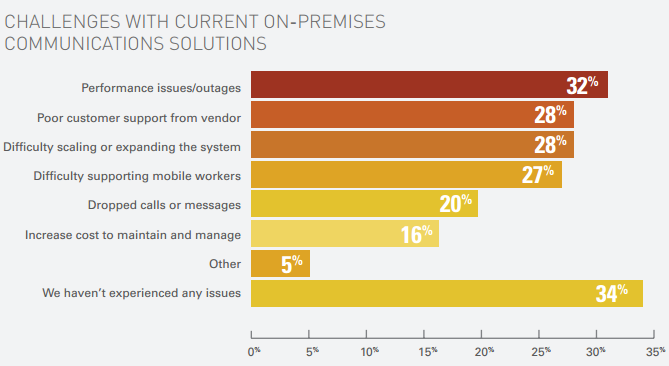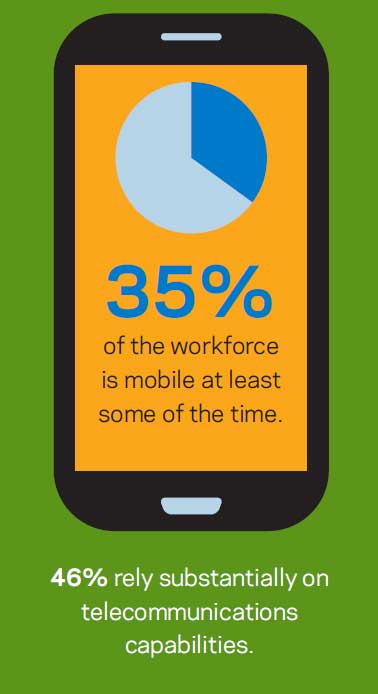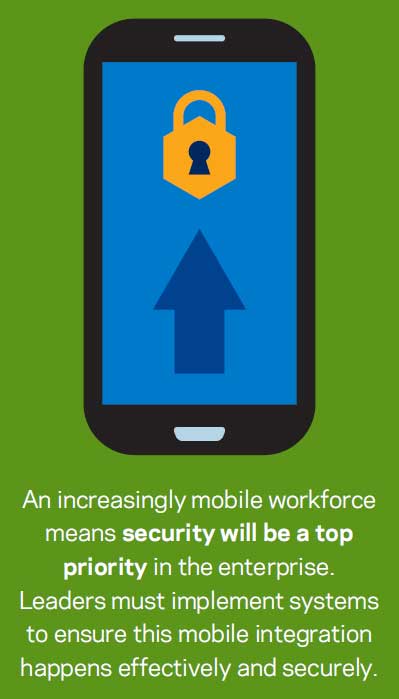 2014 marked the beginning of the Infrastructure Revolution for several industries, many of which are following in the pre-emptive footsteps of the national government.
2014 marked the beginning of the Infrastructure Revolution for several industries, many of which are following in the pre-emptive footsteps of the national government.
In February 2010, the Department of Defense created the Federal Data Center Consolidation Initiative (FDCCI) to reverse the historic growth of Federal data centers. The FDCCI has been seeking to curb this unsustainable increase by reducing the cost of data center hardware, software, and operations; shifting IT investments to more efficient computing platforms; promoting the use of Green IT by reducing the overall energy and real estate footprint of government data centers; and increasing the IT security posture of the government.
Since then, the government has launched an IT modernization effort across departments which includes acquisition and deployment of more secure, collaborative, and mobile technologies—along with their associated skill sets and capabilities—to replace legacy environments.
By shutting down and consolidating under-performing technologies in the Federal inventory, taxpayers stand to save billions of dollars because of curbed spending on underutilized infrastructure. The smartest enterprises will follow suit, carefully architecting their path to modernization, leveraging key partners and modern technology architectures to create a more agile, secure IT environment.
What opportunities does modernization offer?
Legacy networking, communications and applications have become a significant IT and business problem in most industry IT departments. Not only do they require consistent maintenance from someone with a skill set that fewer and fewer people possess, they also carry a high cost of ownership and are difficult to modify when meeting ongoing business demands. Worse, with little leverage across these technologies, they are often forced to remain siloed instances, providing separate benefits to converging infrastructures.
IT modernization represents an opportunity for the evolution of government organizations’ (and others as well) existing application and infrastructure software, the goal being to align IT with forward-looking business strategies.
What are the immediate benefits of modernization?
While the government is actively modernizing its IT infrastructure, they will begin to find that they can react more quickly to the ever-changing environments (business, economic, political, etc). There are many results the public sector can expect from the process of modernizing. Namely:
- Intelligence - with converged infrastructures, including SDNs, virtualization, and distributed applications, leading to complete software-defined data centers with virtualization from desktop-to-network-to-applications.
- Agility - via improved standards for infrastructure programmability, data structure interoperability and fast infrastructure provisioning, leading to a more agile IT organization
- Alignment - by enabling IT practices that are more in line with business objectives.
- Responsiveness - as business changes create flux in organization size, location, and performance, IT is continually challenged to adapt at the speed of your business—a modern infrastructure puts IT in good stead to align with these changes.
- Flexibility and resilience - with systems that adapt automatically and recover from failure more quickly.
- Energy efficienciency - with technology and systems designed to reduce energy consumption.
To get the maximum strategic benefit from modernization, it is important to base your improved system on an architecture that is built on open standards and deployed on open systems. Just as important, is seeking holistic architectural thinking among your vendor suppliers that help you consider how a converged infrastructure can benefit your business.
What are the long-term benefits of modernization?
The success or failure of a consolidation/modernization initiative achieving long-term ROI depends on each organization’s goals. For many public sector businesses, long-term goals include: enhanced security, consolidating the infrastructure, and enhancing mobility.
Enhanced Security
Streamlining IT processes creates an agile IT infrastructure more capable of leveraging existing organizational vehicles for rapid delivery of tasks/orders. But none of this matters without a strong security platform that can withstand the stresses of and better respond to today’s cybersecurity threats.
A modernized IT platform must be hardened and able to detect, respond to, and report information security incidents, as well as developing situational awareness, utilizing authentication, reinforcing reciprocity, and leveraging automated assessments.
Infrastructure Consolidation
Today’s workforce demands applications that are always accessible and work consistently from any device. Public-sector organizations that consolidate their enterprise networks—ultimately standardizing IT platforms, consolidating data and network operations centers, and optimizing architectures—create an infrastructure that is easier to manage and more secure in order to help support active user involvement.
Mobility Enhancement
As with most other industries, there is a significant push for both central and local government and associated not-for-profit agencies to move towards more flexible modes of working. Providing location agnostic access to data is a hot topic for the public sector as is the desire to provide better standards of service to employees and customers. Transparent communication has the potential to accelerate productivity and help realize mission requirements—provided it can be achieved in the face of the escalating austerity of ever-changing security measures.
Modernizing and consolidating IT infrastructures helps address unique resource challenges surrounding public sector enterprise mobility. Consolidation also enables government agencies to implement scalable enterprise mobile management solutions that extend to users, devices, applications, content, data, email and networks.
JITC Certified Unified Communications
Defense agencies are under increasing pressure to bring their disparate web technologies together. That’s why the DoD has created the Joint Interoperability Test Command (JITC) certification, so all IT investments—including collaborative communications solutions—can be protected.
NEC’s UNIVERGE®3C solution has been thoroughly vetted by the JITC against the highest government standards, and has been added to the Defense Information Systems Agency’s Session Controller Approved Products List (APL) for Unified Capabilities.
The APL is a single, consolidated list of products that have been certified and approved for use in DoD networks to provide end-to-end unified capabilities. UNIVERGE 3C is certified as a Local Session Controller, referred to by NEC as Unified Capabilities Session Controller (UC SC).
The JITC evaluation process is highly respected by commercial organizations because JITC testing meets and frequently exceeds enterprise security levels. With Security Officers confident in the solution, the deployment process can be accelerated.
JITC certification requires compliance with hundreds of security measures as well as the ability to withstand extreme attacks on the software. Being JITC accredited means that we fully meet US DoD requirements and often surpass the security best practices of global commercial customers.
Visit us at Enterprise Connect booth 1121 to learn more about NEC’s JITC-Certified UNIVERGE 3C solution.

 Choosing a cloud and SaaS vendor can be tricky for SMBs with small IT organizations and
Choosing a cloud and SaaS vendor can be tricky for SMBs with small IT organizations and 




 With the New Year nearly upon us, now is the time to scrutinize new technologies, business strategies, and capabilities. How will they fit your enterprise? Will they live up to the hype?
With the New Year nearly upon us, now is the time to scrutinize new technologies, business strategies, and capabilities. How will they fit your enterprise? Will they live up to the hype?
 ‘Tis the season for shopping, and three of the U.S’s favorite shopping days—Black Friday,
‘Tis the season for shopping, and three of the U.S’s favorite shopping days—Black Friday, 
 It’s estimated that telecommuters will total 3.9 million people by 2016.The question remains though—can work-from-home teams collaborate effectively with the help of technology?
It’s estimated that telecommuters will total 3.9 million people by 2016.The question remains though—can work-from-home teams collaborate effectively with the help of technology?

 Mobile devices are completely ingrained in our daily lives. They entertain, remind, socialize, and manage us. They are our personal authentication key to the world around us. They are an extension of ourselves. Handheld mobile devices are just extremely personal, more so than any other device we interact with during the day. When asked, most people will say that they’ll give up food or sleep before they’re deprived of their mobile device, and for most there is a discernable level of anxiety when their device isn’t actively with them.
Mobile devices are completely ingrained in our daily lives. They entertain, remind, socialize, and manage us. They are our personal authentication key to the world around us. They are an extension of ourselves. Handheld mobile devices are just extremely personal, more so than any other device we interact with during the day. When asked, most people will say that they’ll give up food or sleep before they’re deprived of their mobile device, and for most there is a discernable level of anxiety when their device isn’t actively with them. The personal dynamics of mobile devices and, in turn, mobile device management, has made adoption of mobile technology a tricky business across the board. For most organizations, Bring Your Own Device (BYOD) policies are still complex and perceived as risky. But, with the global workforce’s rapid adoption of the mobile work style, integration of BYOD policies have been necessary for most organizations to maintain the high levels of productivity needed to sustain business success. In fact, only businesses with high-level security concerns and strict privacy needs—like financial organizations—can succeed in today’s marketplace without some form of acceptance of BYOD in their mobile policies.
The personal dynamics of mobile devices and, in turn, mobile device management, has made adoption of mobile technology a tricky business across the board. For most organizations, Bring Your Own Device (BYOD) policies are still complex and perceived as risky. But, with the global workforce’s rapid adoption of the mobile work style, integration of BYOD policies have been necessary for most organizations to maintain the high levels of productivity needed to sustain business success. In fact, only businesses with high-level security concerns and strict privacy needs—like financial organizations—can succeed in today’s marketplace without some form of acceptance of BYOD in their mobile policies. The key challenges for businesses of all sizes adopting cloud and mobility applications is finding the right balance between usability and data security. In an ideal world, users would like to have one-click access to an increasing number of apps without needing 12 digit passwords for each app. Since users are bringing in their own devices, and these devices are the primary means to app access, they must be “trusted” within the organization and secured.
The key challenges for businesses of all sizes adopting cloud and mobility applications is finding the right balance between usability and data security. In an ideal world, users would like to have one-click access to an increasing number of apps without needing 12 digit passwords for each app. Since users are bringing in their own devices, and these devices are the primary means to app access, they must be “trusted” within the organization and secured.
 What does Unified Communications have in common with Formula One racing?
What does Unified Communications have in common with Formula One racing? The steering wheels are incredibly complicated. The buttons and knobs do everything from controlling the radio, to managing the brake systems, shifting, clutch system, oil intake, brake fluid—and so on. The lights, and now screen, serve as warning mechanisms—letting the driver know when something has gone awry. With the car going up to 340 kilometres per hour (about 211 miles per hour) it becomes increasingly evident that making an error can be dangerous.
The steering wheels are incredibly complicated. The buttons and knobs do everything from controlling the radio, to managing the brake systems, shifting, clutch system, oil intake, brake fluid—and so on. The lights, and now screen, serve as warning mechanisms—letting the driver know when something has gone awry. With the car going up to 340 kilometres per hour (about 211 miles per hour) it becomes increasingly evident that making an error can be dangerous.